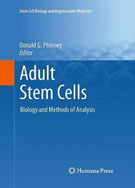Adult stem cells - Biology and methods of analysis

Submitted: 24 May 2011
Accepted: 24 May 2011
Published: 24 November 2011
Accepted: 24 May 2011
Abstract Views: 610
PDF: 359
Publisher's note
All claims expressed in this article are solely those of the authors and do not necessarily represent those of their affiliated organizations, or those of the publisher, the editors and the reviewers. Any product that may be evaluated in this article or claim that may be made by its manufacturer is not guaranteed or endorsed by the publisher.
All claims expressed in this article are solely those of the authors and do not necessarily represent those of their affiliated organizations, or those of the publisher, the editors and the reviewers. Any product that may be evaluated in this article or claim that may be made by its manufacturer is not guaranteed or endorsed by the publisher.

 https://doi.org/10.4081/ejh.2011.br14
https://doi.org/10.4081/ejh.2011.br14










